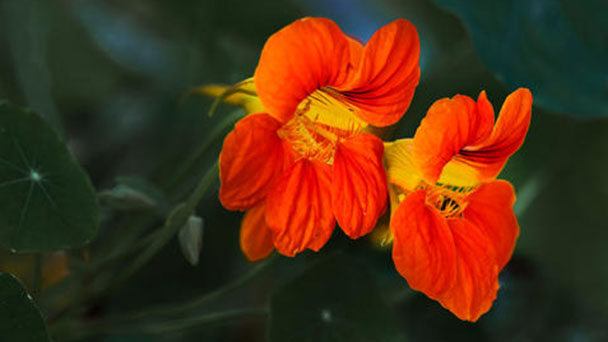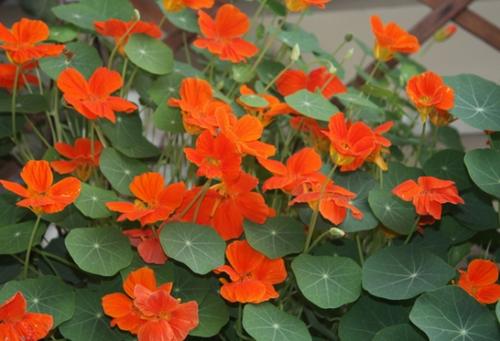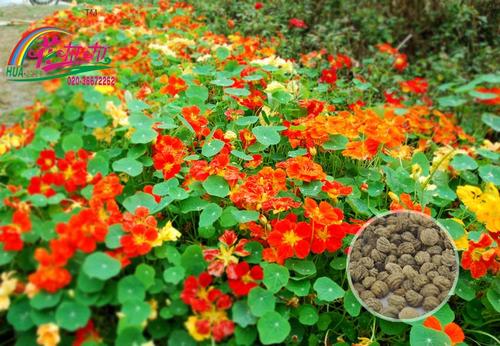Nasturtium (Tropaeolum majus) profile
Written by Maggie
Oct 28 2021

Nasturtium (Tropaeolum majus) is a rare wild plant of the genus Nasturtium, family Nasturtium. Nasturtium is a one-year or perennial climbing plant. Plant height is 30 cm - 70 cm. Basal leaves are long-stalked, leaf blade pentagonal, tripartite, second lobes with a few lobules and sharp teeth. Flowers are solitary or 2-3 in cymes, sepals 8-19, yellow, elliptic obovate or obovate, petals as long as sepals, narrowly lobed. Leaf fat beautiful flowers, the is color purple, orange, milky yellow, golden lotus flower stems winding, leaf shape such as bowl lotus, milky yellow flowers in full bloom, such as butterflies flying, is an important summer ornamental flowers. The flowers of Nasturtium can be used as medicine. Its tender shoots, buds and fresh seeds can be used as a spicy seasoning.
Nasturtium Picture

Nasturtium Info
| Botanical Name | Tropaeolum majus |
| Common Names | Nasturtium |
| Plant Type | Annual flower |
| Sun | Full sun |
| Hardiness Zones | 2 to 11 (annual) |
| Flower color | Red, orange, pink, yellow, cream |
| Native Area | Central and South America |
| Mature size | 1 to 10 feet tall and 1 to 3 feet wide |
Characteristics of Nasturtium
Nasturtium Stems
Nasturtium is cultivated annually for perennials, stems and leaves slightly fleshy, herbaceous, semi-trailing, glabrous or sparsely hairy.
Nasturtium Leaf
Leaves of Nasturtium are alternate; Petiole is 6 -- 31 cm long, twisted upward, peltate, inserted near the center of leaf blade; Leaf blade is rounded, 3-10 cm in diameter, with 9 main veins. Radiating from the petiole to all sides, the margin is a wavy shallow notch, the back is usually sparsely hairy or has a milky projection.
Nasturtium Flowers
Nasturtium single flower is axillary, stalk 6 -- 13 cm long; Flowers are yellow, purple, orange, or variegated, 2.5 -- 6 cm in diameter; Receptacle is cup-shaped; Nasturtium has 5 sepals, long elliptic-lanceolate, 1.5 -- 2 cm long, 5 -- 7 mm wide, basally connate, margin membranous, one elongated into a long spur, 2.5 -- 3.5 cm long, acuminate; Nasturtium has 5 petals, usually rounded, margin notched, upper 2 usually entire, 2.5 -- 5 cm long, 1 -- 1.8 cm wide, bearing at the opening of the spur, lower 3 bases narrow into claws, margin lashes near the claws; Nasturtium has 8 stamens, long and short intermutate, separate; Ovary is 3-loculed, style 1, stigma 3-lobed, linear.
Nasturtium Fruit
The fruit of Nasturtium is oblate and split into three achenes with a single seed at maturity.
Habits of Nasturtium
Nasturtium is not cold tolerant and can tolerate 0℃ for a short period. It likes warm and wet, and the overwintering temperature is above 10℃. Good, sunny and well-drained soil is needed. Flowering in summer, February-May. The suitable temperature for growth is 18-24℃. It is not easy to flower in high temperatures in summer, and the growth is inhibited above 35℃. Nasturtium is often cultivated in the north. In suitable environmental conditions, flowers can be all year round. Nasturtium can last 8-9 days, the whole plant can be out of dozens of flowers at the same time, the aroma is pungent, the color is gorgeous, has won the love of people.
How to Grow & Care for Nasturtium
1. Environment
Nasturtium prefers mild climates and is not resistant to cold and heat.
2. Soil
Potted Nasturtium, it is advisable to choose leaf rot soil 4 points, garden soil 4 points, compost soil 1, sand soil 1 mixed preparation of culture soil.
3. Light
Nasturtium likes to have enough light, direct sunlight is not acceptable in summer, proper shade should be placed in a cool and ventilated place, in North China in the middle of October, placed indoors, placed in the place where the sun can shine. In winter, the room temperature is kept at about 15℃ and the sun is sufficient, so they can continue to grow and develop.
4. Water
Nasturtium breeding, first of all, we should know that Nasturtium is wet afraid of waterlogging, soil moisture to maintain about 50%, during the growth of watering to take small water frequently watering method, 2-3 days in spring and autumn season watering once, every day in summer watering, and in the evening to the leaf spraying, to maintain higher humidity.
5. Fertilizer
During the growth of Nasturtium, the growth process is generally applied once every 3-4 weeks with a concentration of 15% of the rarefied decapitate fertilizer water, in the flowering period to stop the application of nitrogen fertilizer, 0.5% calcium superphosphate, applied once every half a month, can make the leaves green, flowering flourishing.
6. Temperature
The best temperature of Nasturtium is 18 ~ 24℃, and it is afraid of high temperature. It is difficult to blossom in summer when the temperature is too high, and the growth slows down or stops when the temperature is higher than 35℃. Nasturtium is not hardy and can survive only for a short time at 0 ° C. Winter temperatures should be higher than 10 ° C to facilitate winter survival.

How to Propagate Nasturtium
Propagate Nasturtium from Seed
Under normal circumstances seeding period: spring, called spring sowing. Flowering from summer to winter.
It is also possible to sow seeds in autumn, which is called autumn sowing. This will allow Nasturtium to bloom around New Year's Day and Spring Festival.
Seeding and seedling raising: the suitable temperature for germination 18-20 degrees. Sow on demand, cover with soil about 1 cm, pour permeable and keep moist, germinate for 7 days. Pick the heart basin when 2-3 true leaves, properly arrange the leaves and branches to facilitate ventilation, so that the flowers exposed.
Propagate Nasturtium from Cutting
Cottage in spring to summer, select limited tender stem as cuttings, remove the lower leaves, after shading, maintain humidity, 2 to 3 weeks can root. With the growth of stems and tenderness, bamboo should be set up in time, binding branches and tenderness. Topdressing every 10-15 days and maintain adequate moisture and high air humidity throughout the growth period.
Each Nasturtium has eight stamens and one pistil, of which eight stamens are not mature at the same time. And until all the pollen has been dispersed, the pistil is mature and extends to the mouth of the flower bell.
Nasturtium Disease Control
Nasturtium has fewer pests and diseases.
The main pest of Nasturtium is the leaf-minder moth, which uses its larvae to penetrate into the new shoots and young leaves of the plant and forms winding worm paths in the damaged layer of the upper and lower epidermis, making the whole new shoots and leaves unable to stretch and easy to fall off. When serious, can make autumn shoot all withered yellow.
[Regularity of occurrence] It can occur for about 10 generations a year, and the pupae and larvae overwinter on the damaged leaves. Every year in spring, the larvae began to harm, summer to autumn is the peak period, the harm is also serious. The lowest decrease occurred after October. It takes more than 20 days to complete a generation. Most of the adults emerged in the early morning, perched in the back of leaves and weeds during the day, and were active at night with strong phototaxis. They lay eggs in the evening of the second to the third day after copulation. The eggs are mostly laid near the midvein on the back of young leaves of Nasturtium. There are several grains per leaf. Each female can lay 40-90 eggs, with an average of about 60 eggs. After hatching, the larva sneaks into the leaf epidermis from the bottom of the egg, feeds on mesophyll, progresses while eating, and gradually forms the curved worm path. Mature, mostly caries to the edge of the leaf, worm body in which the spinneret knot thin cocoon pupation, often resulting in leaf edge rolled up. Seedling and young trees, due to the number of shoot and irregular, suitable for adult spawning and larval damage, often more serious than the adult tree.
Insects and diseases: the growth of the Nasturtium should be observed frequently during the growth of the Nasturtium plant. Use some bactericidal, insecticidal kind of medicaments, will prevent and cure mold or is red spider's encroachment.
Distribution of Nasturtium
Nasturtium is distributed in Hebei, Jiangsu, Fujian, Jiangxi, Guangdong, Guangxi, Yunnan, Guizhou, Sichuan, Xizang and other provinces and regions are cultivated as potted or open ornamental flowers, sometimes unripe. Nasturtium is native to South America, Peru, Brazil and other places. Nasturtium is widely introduced in our country as an ornamental plant for courtyards or greenhouses.
Nasturtium is originally produced in South America, Peru, Chile, Central and South America.
Varieties of Nasturtiums
There are dozens of species of nasturtiums, including:
'Alaska' Series: These are bushy dwarf plants with heavily variegated foliage and blossoms above the foliage.
'Jewel' Series: This series includes bushy dwarf plants with double and semi-double blooms. They're profuse bloomers, but the flowers tend to get lost under the foliage.
'Peach Melba': These bushy dwarf plants with semi-double buttery yellow flowers splashed with orange-red centers are good for containers.
'Canary Creeper': This is a perennial vine within the nasturtium genus that has yellow flowers that look like a bird’s wings.
Nasturtium Uses
Nasturtium is golden and bright with a refreshing taste. It has the functions of clearing heat and detoxification, nourishing Yin decreases internal heat, nourishing Yin and clearing heat and disinfecting fire and sterilization. Long-term drinking can clear pharynx, moisten the throat and clear voice. Especially for chronic pharyngitis, laryngitis, tonsillitis and hoarseness with anti-inflammatory, preventive and therapeutic effects, engaged in broadcasting, vocal music, education and communication and other voice professionals have a special health care treatment effect, can put the right amount of sugar, wolfberry, licorice, jade bamboo and another drinking together, the effect is better. Nasturtium tea is a kind of high-quality folk tea, which is always available in Chengde people's homes.
The leaves of Nasturtium are plump and beautiful in the shape of lotus flowers, and when the milky yellow flowers are in full bloom, in the deep mountains above Chengde Dam there are large fields of natural and wild lotus flowers. In the full bloom season of Nasturtium, the flowers are in full bloom, and the scenery is magnificent, and the butterflies fly in the air, which is of special interest. Potted Nasturtium can be used for indoor viewing or decoration of balconies and windowsills.

Read Next:
Top 10 Most Beautiful Roses in the World
Top 10 Most Beautiful Flowers in the World
26 Best Autumn Flowers to Plant for Fall Color in Garden
Latest Updated
- Benefits of Bugleweed - 7 Science-backed Health Benefits
- Bugleweed Dangers & Side Effects - Is It Poisonous?
- How to Plant Evergreen Trees - What You Should Know
- When to Plant Evergreens - Grow Guide for Evergreen Trees
- 12 Wonderful Evergreen Shrubs for Your Garden
- 12 Popular Evergreen Plants with Pictures for Beginners
- When And How To Prune A Lilac Bush Like a Pro
- How to Grow & Care for Lilac Vine (Hardenbergia Violacea)
- Japanese Lilac Tree (Syringa Reticulata) Care & Propagation Guide
- Shumard Oak Pros and Cons - What to Know
Popular Articles
- Winter maintenance of Antirrhinum Majus
- How to Grow Terminalia Mantaly Tree
- How to Grow and Care for Crossostephium Chinense
- How to grow Antirrhinum Majus in spring
- Peristeria Elata (Dove Orchid) Profile: Info & Care Guide
- Underwatered Snake Plant (Sansevieria Trifasciata) - Signs And How To Fix
- How to Care for Brazilian Jasmine Plant (Mandevilla Sanderi)
- How to Grow & Care for Graptopetalum Purple Delight in Summer
- Rosa Chinensis (China Rose): Plant Growing & Care Tips
- How to Care for Baby Sun Rose (Aptenia Cordifolia)